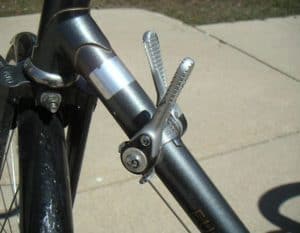In the world of cycling, there are many gear shifter brands, but they all fall into two main groups; indexed or friction shifters. So, what is the Comparison between friction shifters vs indexed shifters?
Indexed shifters have calibration notches that move like stairs making click sounds as you change gears. The cable moves a specific distance with each click. Friction shifters don’t have ratchets but move linearly without clicking.

In the two systems, a rider uses levers to regulate tension in the derailleur cable, and then the cable pulls the derailleur to shift gears.
What Is An Indexed Shifter?
An indexed shifter is a bicycle gear shifting mechanism with notches arranged in a helical manner. It is sometimes referred to as “indexed gearing” or an “indexed gear.”
With a well-set indexed shifter, changing gears is easy even for beginners. As you move the lever over each notch, the system produces a clicking sound.
Each click signals that the derailleur has moved one gear up or down.
What Are Friction Shifters?
Friction shifting is changing gears up and down without any indexing. As such, there are no notches or clicks to indicate how many cogs you have shifted.
Before 1980, cyclists predominantly used friction shifters.
However, the idea of an indexed shifter has been around since the late 1960s. In 1977, Shimano introduced the technology on Positron rear derailleur, but it wasn’t easy to use.
Luckily, the Shimano Indexing System came not long after and changed the whole story about bike gear shifting.
How Does An Index Shifter Work?
Like traditional friction shifters, indexed shifters use a cable to exert tension on the derailleur that moves the chain from one cog to another.
All the same, there is a significant difference in how the system changes gears.
Every indexed shifting system has a preset cable pull to cage movement ratio. Therefore, for every notch you move the shifter, the chain moves one step up or down.
With every click of the system’s ratchet, indexed shifters pull or release an amount of cable that s enough to move the chain from one gear to the other.
Shifting gears can be an uphill task in case the shifter and the cassette are not compatible. For example, it is impossible to use a seven-gear indexed shifter with a ten-speed cassette.
Therefore, if you plan to upgrade your vintage bike from friction to indexed shifters, it is advisable to find a system that is compatible with your drivetrain.

For example, for your bike has a 10-speed cassette, you can go for the SHIMANO SL-M640 Zee 10 Speed Shifter, which has a two-way release to allow the rider to shift with the thumb or finger.
Pros Of Indexed Shifters
1. Indexed Shifters Are Easy To Use For Beginners
If you’re starting out cycling, using indexed shifters is a great way to start. They’re easy to learn and use. There is no learning curve since you only need to follow the clicks, and you will shift gears right.
2. Indexed Shifter Systems Are Readily Available
Since they hit the market in volumes in the early 1980s, indexed shifters have become readily available. Most manufacturers have been moving away from traditional shifters.
Almost all the bikes in the dealer shops today have indexed shifting systems.
As a result, it is easier to find replacements for broken components. Also, when riders want to upgrade to index shifting, index shifting sets are readily available at the local bikes shop.
3. Riders Can Shift More Often
There are minimal chances of miss-shifting. With index sifting, riders don’t work to work out how much cable to pull. With the correct cable adjustment, a certain number of notches move the cage to a preset cog. Therefore, since changing gears with this system is semiautomatic, riders can shift gears more without the chain falling between the cogs.
4. They Are Best for Race Bikes
When in a competition, riders wouldn’t like to second guess when changing gears. Fortunately, index shifters help riders change gears with little or no chances of the chain landing between the cogs.
Notably, miss-shifting is a common problem with friction shifting, especially for beginners.
Disadvantages Of Indexed Shifters
1. The Setting Has To Be Precise
For index shifters to work flawlessly, the tune-up has to be on point. Also, index shifters can’t work when one component of the drivetrain malfunctions.
2. Drivetrain Adjustment Is A Bit Complex
When it comes to synchronizing the drivetrain with index shifters, you need some expertise. Not every bike owner can adjust or tune-up the indexed shifting system.
3. Index Shifters Are More Expensive
Compared to friction shifters, index shifters cost more. Actually, some bike owners revert to using friction shifters due to the cost of indexed shifters when they need to replace broken systems.
4. Index Shifters Don’t Work With A Wide Range Of Cogs.
One of the significant drawbacks of index shifters is that they can only work with a specific speed cassette. Therefore, if your bike works with a 10-speed cassette, it has to be ten-speed.
If you change the number of cogs, you have to change the shifters or reset them. This makes them less appealing to touring and mountain bikers who ride far from major towns.
Friction Shifters Vs Indexed Shifters – Are Friction Shifters Good?
Comparing friction shifters vs indexed shifters, friction shifters are suitable for riders who travel to places where a dramatic shifter failure would be catastrophic.
Also, friction shifters are because their tune-up doesn’t have to be crisp precise. As such, mountain bikers would find these shifters better than the indexed ones.
Even if the drivetrain is slightly faulty, friction shifters will work, unlike the indexed type. Also, the system is versatile and can work with a wide range of gears. This feature makes friction shifters suitable for touring bikes.
Pros Of Friction Shifters
1. They Are Compatible With A Wide Range Of Drivetrains
One good thing about friction shifters is that they can work with a wide range of cassettes. For example, if you want to upgrade your 7-speed bike to a nine-speed, you don’t need a new shifter.
For this reason, friction derailleurs are the favorite for most touring cyclists. If the drivetrain fails during the trip, the rider can change the faulty part without much to worry about.
2. Friction Shifters Are Easy To Maintain
Generally, friction shifters are easier to maintain than indexed ones. The system is easy to assemble, making it easy to clean and maintain by any bike owner.
When you need to clean the levers and their components to make shifting flawless, you don’t need any tools.
Notably, the system is held together by a wing thumb screw, which makes disassembling and assembling less demanding.
So, the friction shifter system is easy to clean for a better shifting experience.
3. Requires Less Tune-Up
When you change a single drivetrain component such as the cable, you need to reset your derailleur to ensure every click lands on the right gear. The cable tension has to be precise at all times.
Well, this is only true with indexed shifters.
For fiction shifters, all you have to do is you don’t need any unique tools or skills. Actually, anybody can change the cable and get going.
4. Friction Shifters Are Relatively Cheaper
Friction shifters are available at some unbelievably low prices. For example, shifters such as the MECO Variable Speed Bicycle Shifters go for less than $15 and are compatible with almost any drivetrain.
Therefore, replacing the shifting system doesn’t cost much in case of a breakdown, and even beginners can afford to buy a new set.
Cons Of Friction Shifters
- It takes time to learn how to use friction shifters
- Most manufacturers no longer produce friction shifters
Why Has Indexed Shifting Displaced Friction Shifting?
Every seasoned rider will tell you that index shifting has overtaken friction shifting. Well, some of the reasons for this change include:
1. Indexed Shifter Are More Beginner Friendly
As discussed earlier, index shifters have ratchet notches that produce a clicking sound whenever you push the levers. These clicks help in guiding beginners on how far to push or release the levers.
For beginners, there isn’t a learning curve as in friction shifting. Actually, this is one of the major reasons why index shifting has pushed their predecessors almost out of the market.
2. Indexing Ensures No Miss-Shifting
The other primary reason why index shifters have gained popularity over friction shifters is that gear selection is easy and precise.
Each clicking sound from the lever indicates that the chai has moved a specific distance up or down the cassette.
As a result, it is hard to miss-shift with indexed systems, even for a beginner.
3. You Can Turn Off The Indexing
In case one component of the drivetrain malfunctions, the index shifting may not work. For example, if the derailleur hanger gets bent or the chain tension isn’t proper, index shifting cannot help.
To help riders navigate this challenge, especially when riding for long distances, manufacturers have made it possible to switch off the indexing function.
Once you switch off the indexing, the system works like a friction shifter and gives you the freedom to change gears the traditional way.
Friction Shifters vs Indexed Shifters – Similarities
Friction and indexed shifter may sound a though they are a world apart to a beginner. However, the two systems have a lot of similarities despite their few differences. Some of the similarities include:
- The two systems are cable-actuated
- They Work pushing or releasing the cage to the desired gear
- Levers for the two systems can mount on the handlebars or the downtube
- The two systems are suitable for race bikes depending on the rider’s preference and experiences. Some will swear while others can’t let go of the other.
Frequently Asked Questions
1. Do You Grease Friction Shifters?
Generally, you don’t grease friction shifters. On the other hand, if you dismantle the shifters and clean them, you can carefully lubricate where appropriate not to inhibit the required friction for functionality.
2. Can A Bike Work Without Derailleur?
Any bike can work without a derailleur though that is not their default status. If the derailleur breaks down, the cyclist can rig it and get home. In addition, you can also replace the rear cassette with a single-speed freewheel.
3. What Are Bicycle Brifters?
“Brifters” is a name given to a braking system that has gear shifting integrated into brake levers. Therefore, cyclists don’t have to move their hands to change gears.
4. What Is STI In Road bikes?
STI in bikes are initials that stand for Shimano Total Integration. This term refers to systems that have braking and gear shifting in one lever made by Shimano.
Also Read: Downtube Shifters Vs Bar End Shifters
Final Word – Friction Shifters Vs Indexed Shifters
Indexed shifters are an improvement on the friction shifters. The latter has notches that work like stairs, while the former works like a continuous ramp.
The notches in index shifters make it easy for beginners to change gears without hitches.
On the other hand, friction shifters are versatile. They allow the shifting of gears even when one component is not in its best condition. So, the two systems have their advantages and disadvantages.